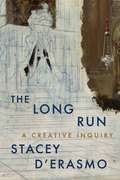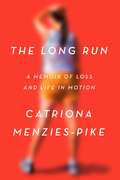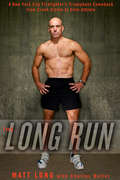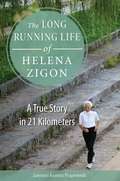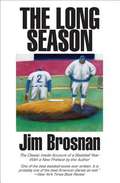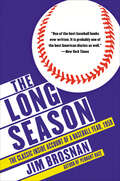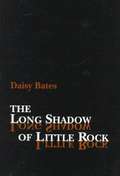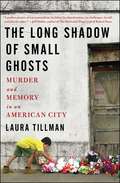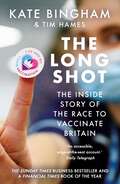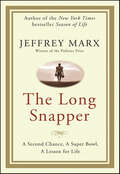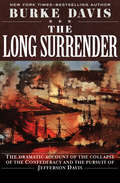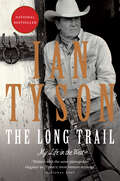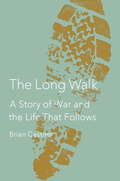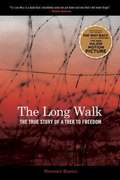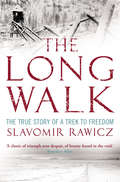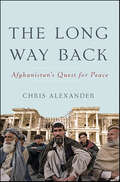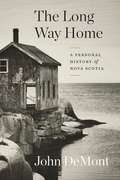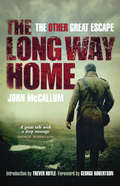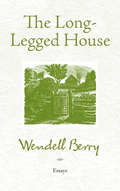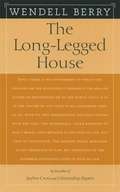- Table View
- List View
The Long Run
by Catriona Menzies-PikeNo one ever expected Catriona Menzies- Pike to run a marathon. She hated running, and was a hopeless athlete. When she was twenty her parents died suddenly - and for a decade she was stuck. She started running on a whim, and finally her grief started to move too. Until very recently, it was frowned upon for women to run long distances. Running was deemed unladylike - and probably dangerous. How did women's running go from being suspect to wildly popular? How does a high school klutz become a marathon runner? This fascinating book combines memoir and cultural history to explore the rich and contradictory topic of women and running.
The Long Run: A Creative Inquiry
by Stacey D'ErasmoThe author of The Art of Intimacy asks eight legendary artists: What has sustained you in the long run?How do we keep doing this—making art? Stacey D’Erasmo had been writing for twenty years and had published three novels when she asked herself this question. She was past the rush of her first books and wondering what to expect—how to stay alive in her vocation—in the decades ahead.She began to interview older artists she admired to find out how they’d done it. She talked to Valda Setterfield about her sixty-year career that took her from the Merce Cunningham Dance Company to theatrical collaborations with her husband to roles in films. She talked to Samuel R. Delany about his vast oeuvre of books in many genres. She talked to Amy Sillman about working between painting and other media and between abstraction and figuration. She talked to landscape architect Darrel Morrison, composer Tania Léon, actress Blair Brown, and musician Steve Earle, and started to see connections between them and to artists across time: Colette, David Bowie, Ruth Asawa. She found insights in own experience, about what has driven and thwarted and shaped her as a writer.Instead of easy answers or a road map, The Long Run offers one practitioner’s conversations, anecdotes, confidences, and observations about sustaining a creative life. Along the way, it radically redefines artistic success, shifting the focus from novelty and output and external recognition toward freedom, fluidity, resistance, community, and survival.
The Long Run: A Memoir of Loss and Life in Motion
by Catriona Menzies-PikeAn unlikely marathoner finds her way through grief and into the untold history of women and running.Thirty-year-old Catriona Menzies-Pike defined herself in many ways: voracious reader, pub crawler, feminist, backpacker, and, since her parents' deaths a decade earlier, orphan. "Runner" was nowhere near the list. Yet when she began training for a half marathon on a whim, she found herself an instant convert. Soon she realized that running, "a pace suited to the precarious labor of memory," was helping her to grieve the loss of her parents in ways that she had been, for ten messy years, running away from. As Catriona excavates her own past, she also grows curious about other women drawn to running. What she finds is a history of repression and denial—running was thought to endanger childbearing, and as late as 1967 the organizer of the Boston Marathon tried to drag a woman off the course, telling her to "get the hell out of my race"—but also of incredible courage and achievement. As she brings to life the stories of pioneering athletes and analyzes the figure of the woman runner in pop culture, literature, and myth, she comes to the heart of why she's running, and why any of us do.
The Long Run: A New York City Firefighter's Triumphant Comeback from Crash Victim to Elite Ath lete
by Matt Long Charlie ButlerA New York City firefighter's emotional and inspiring memoir of learning to run again after a debilitating accidentOn the morning of December 22, 2005, Matt Long was cycling to work in the early morning when he was struck by and sucked under a 20-ton bus making an illegal turn. The injuries he sustained pushed him within inches of his life. Miraculously, more than 40 operations and months later, Matt was able to start his recovery. In spite of the severity of his injuries, Matt found the psychological consequences of the accident nearly as hard to process. He would no longer be able to compete at the highest level.In the 18 months before the accident, he had competed in more than 20 events including several triathlons and marathons and had qualified for running's most prestigious race, the Boston Marathon. After the accident, his doctor told him he'd be lucky if he could even walk without a cane.The Long Run is an emotional and incredibly honest story about Matt's determination to fight through fear, despair, loneliness, and intense physical and psychological pain to regain the life he once had. The book chronicles Matt's road to recovery as he teaches himself to walk again and, a mere three years later, to run in the 2008 New York City Marathon—a gimpy seven-and-a-half hour journey through the five boroughs. "Running saved my life," Matt says, and his embrace of the running community and insistence on competing in the marathon has inspired many, turning him into a symbol of hope and recovery for untold numbers of others.
The Long Running Life of Helena Zigon: A True Story in 21 Kilometers (NIU Series in Slavic, East European, and Eurasian Studies)
by Jasmina Kozina PraprotnikAnthropologist Jasmina Praprotnik met Helena Zigon while running. Over the course of an icy Slovenian winter, the two marathon runners got together frequently, and Zigon told Praprotnik about her life. Here, Praprotnik tells Zigon's captivating story in Zigon's own voice. Each chapter is marked by a kilometer of the half-marathon Zigon ran along the Adriatic Sea on her eighty-sixth birthday, shortly after losing her husband of sixty years, Stane. Zigon's life spanned most of the twentieth century. She witnessed the Second World War, the rise and fall of Yugoslavia, and the founding of the new state of Slovenia. Abandoned by her parents and having grown up poor and mistreated by her stepmother, Zigon demonstrates the stoic resilience of a long-suffering Slavic woman. Though beset with challenges, she found a source of strength in the act of running. From a young girl running errands to an old woman running in the face of new grief, running has been a bright thread braided throughout her life. It has served her as a balm and a joy—one that she is grateful to still be able to savor. This inspirational memoir will appeal to general readers, especially those interested in history and running.
The Long Season
by Jim BrosnanThe classic inside account of a baseball year by a major league pitcher.
The Long Season: The Classic Inside Account of a Baseball Year, 1959
by Jim Brosnan“Takes readers inside the clubhouse, the dugout, and the bullpen-not to mention the airplane, the train and the hotel room-in ways no sportswriter ever has.” — Washington Post“Rich and always interesting....This is the most authentic and convincing book about baseball I have ever read.” — Los Angeles Times“Funny, candid, and even more interesting because it doesn’t chronicle an exceptional season (something Brosnan reserved for his second book, Pennant Race, 1962), this book was a game changer.” — Booklist“One of the best baseball books ever written. It is probably one of the best American diaries as well.” — New York Times
The Long Shadow Of Little Rock
by Daisy BatesFor many Americans, until recently, knowledge about Arkansas has been limited to one of the state's moments of ignominy: the Central High School desegregation crisis in Little Rock in 1957. In this memoir, Daisy Bates recounts the conflict as only a journalist hardened and polished by years of struggle in the civil rights movement could tell it.
The Long Shadow of Small Ghosts: Murder and Memory in an American City
by Laura TillmanIn Cold Blood meets Adrian Nicole LeBlanc's Random Family: A harrowing, profoundly personal investigation of the causes, effects, and communal toll of a deeply troubling crime--the brutal murder of three young children by their parents in the border city of Brownsville, Texas.On March 11, 2003, in Brownsville, Texas--one of America's poorest cities--John Allen Rubio and Angela Camacho murdered their three young children. The apartment building in which the brutal crimes took place was already rundown, and in their aftermath a consensus developed in the community that it should be destroyed. It was a place, neighbors felt, that was plagued by spiritual cancer. In 2008, journalist Laura Tillman covered the story for The Brownsville Herald. The questions it raised haunted her, particularly one asked by the sole member of the city's Heritage Council to oppose demolition: is there any such thing as an evil building? Her investigation took her far beyond that question, revealing the nature of the toll that the crime exacted on a city already wracked with poverty. It sprawled into a six-year inquiry into the larger significance of such acts, ones so difficult to imagine or explain that their perpetrators are often dismissed as monsters alien to humanity. With meticulous attention and stunning compassion, Tillman surveyed those surrounding the crimes, speaking with the lawyers who tried the case, the family's neighbors and relatives and teachers, even one of the murderers: John Allen Rubio himself, whom she corresponded with for years and ultimately met in person. The result is a brilliant exploration of some of our age's most important social issues, from poverty to mental illness to the death penalty, and a beautiful, profound meditation on the truly human forces that drive them. It is disturbing, insightful, and mesmerizing in equal measure.
The Long Shot: The Inside Story of the Race to Vaccinate Britain
by Kate Bingham Tim HamesHow Covid-19 vaccines went from the laboratory to people&’s arms – the inside story of an extraordinary national campaign against all oddsThe Sunday Times bestseller FT Book of the Year On 3 April 2020, Kate Bingham was told that the likelihood of any Covid-19 vaccine working was 15% at best. But on 8 December 2020, the first NHS patient received a vaccine. Now nearly every adult in Britain has had a jab, lockdowns have ended and we can finally live with Covid. What lies behind this staggering success story? From a cottage miles away from Westminster, Bingham juggled vaccine suppliers, Whitehall, the media circus – and her daughter&’s exams. Political manoeuvring, miscommunications and administrative meddling nearly jeopardised the project. But perseverance paid off. Catapulted into a national crisis, Bingham&’s eclectic team secured the first vaccine doses administered in the West and saved thousands of lives in the UK as new variants struck. This is an unmissable insider view into how the Vaccine Taskforce beat the odds and delivered the scientific miracle we all waited for.
The Long Snapper: A Second Chance, a Super Bowl, a Lesson for Life
by Jeffrey MarxWritten by Pulitzer Prize-winning journalist Jeffrey Marx, The Long Snapper chronicles one of the most improbable and inspirational sports stories of our time. Marx, the New York Times bestselling author of Season of Life, tells of Brian Kinchen’s remarkable journey from Bible teacher to New England Patriot to Super Bowl champion in this transcendent tale of football and faith.
The Long Surrender
by Burke DavisA panoramic and spellbinding history of the last days of the Confederacy and the flight, capture, and imprisonment of Jefferson Davis In April 1865, Richmond fell to the Union army and Gen. Robert E. Lee surrendered to his Northern counterpart, Ulysses S. Grant, at the Appomattox Court House. But the Civil War was far from over. Determined to keep Confederate dreams of secession alive, President Jefferson Davis and his cabinet fled the burning capital city. With Union troops in pursuit, the fugitives rallied loyalists across the South and made plans to escape to Cuba. In the aftermath of President Abraham Lincoln&’s assassination, a $100,000 bounty was placed on Davis&’s head. Finally captured in Irwinville, Georgia, the former US senator and secretary of war became a prisoner of the American government. The harsh treatment he received would inflame tensions between North and South for years to come. Meticulously researched and brilliantly told, The Long Surrender brings these dramatic events to vivid, unforgettable life and paints a fascinating portrait of Davis, one of history&’s most enigmatic figures. By shining a light on this forgotten chapter of the Civil War, bestselling author Burke Davis examines the lasting impact of America&’s bloodiest conflict on the national character.
The Long Trail: My Life in the West
by Ian TysonA Canadian icon on his longstanding love of the West and his life in "one of the last true cowboy countries on either side of the border.""I live on a ranch about six miles east of the town of Longview and the old Cowboy Trail in the foothills of the Rockies. On a perfect day, like today, I can't imagine being anywhere else in the world. Of course, I'm not going to say there aren't those other days when you think, 'What am I doing here?' It's beautiful country and it can be brutally tough as well." --Ian TysonIan Tyson's journey to the West began in the unlikely city of Victoria, BC, where he rode his dad's horses on the weekends and met cowboys in the pages of Will James's books, and eventually followed that cowboy dream to rodeo competition. Laid up after breaking a leg, he learned the guitar, and drifted east, becoming a key songwriter and performer in the folk revival movement. But the West always beckoned, and when his marriage to his partner and collaborator Sylvia broke up and the music scene threatened to grind him down, he retreated to a ranch and work with cutting horses. Soon, he'd bought a ranch in Alberta and found a new voice as the renowned Western Revival singer-songwriter and horseman he is today. This book is Ian's reflection on that journey...From the Hardcover edition.
The Long Voyage
by Malcolm CowleyCritic, poet, editor, chronicler of the "lost generation," and elder statesman of the Republic of Letters, Malcolm Cowley (1898-1989) was an eloquent witness to much of twentieth-century American literary and political life. These letters, the vast majority previously unpublished, provide an indelible self-portrait of Cowley and his time, and make possible a full appreciation of his long and varied career. Perhaps no other writer aided the careers of so many poets and novelists. Faulkner, Fitzgerald, Hemingway, Kerouac, Tillie Olsen, and John Cheever are among the many authors Cowley knew and whose work he supported. A poet himself, Cowley enjoyed the company of writers and knew how to encourage, entertain, and when necessary scold them. At the center of his epistolary life were his friendships with Kenneth Burke, Allen Tate, Conrad Aiken, and Edmund Wilson. By turns serious and thoughtful, humorous and gossipy, Cowley's letters to these and other correspondents display his keen literary judgment and ability to navigate the world of publishing. The letters also illuminate Cowley's reluctance to speak out against Stalin and the Moscow Trials when he was on staff at The New Republic--and the consequences of his agonized evasions. His radical past would continue to haunt him into the Cold War era, as he became caught up in the notorious "Lowell Affair" and was summoned to testify in the Alger Hiss trials. Hans Bak supplies helpful notes and a preface that assesses Cowley's career, and Robert Cowley contributes a moving foreword about his father.
The Long Walk: A Story of War and the Life That Follows
by Brian CastnerIn the tradition of Michael Herr's Dispatches and works by such masters of the memoir as Mary Karr and Tobias Wolff, a powerful account of war and homecoming.Brian Castner served three tours of duty in the Middle East, two of them as the commander of an Explosive Ordnance Disposal unit in Iraq. Days and nights he and his team--his brothers--would venture forth in heavily armed convoys from their Forward Operating Base to engage in the nerve-racking yet strangely exhilarating work of either disarming the deadly improvised explosive devices that had been discovered, or picking up the pieces when the alert came too late. They relied on an army of remote-controlled cameras and robots, but if that technology failed, a technician would have to don the eighty-pound Kevlar suit, take the Long Walk up to the bomb, and disarm it by hand. This lethal game of cat and mouse was, and continues to be, the real war within America's wars in Iraq and Afghanistan. But The Long Walk is not just about battle itself. It is also an unflinching portrayal of the toll war exacts on the men and women who are fighting it. When Castner returned home to his wife and family, he began a struggle with a no less insidious foe, an unshakable feeling of fear and confusion and survivor's guilt that he terms The Crazy. His thrilling, heartbreaking, stunningly honest book immerses the reader in two harrowing and simultaneous realities: the terror and excitement and camaraderie of combat, and the lonely battle against the enemy within--the haunting memories that will not fade, the survival instincts that will not switch off. After enduring what he has endured, can there ever again be such a thing as "normal"? The Long Walk will hook you from the very first sentence, and it will stay with you long after its final gripping page has been turned.From the Hardcover edition.
The Long Walk: The True Story of a Trek to Freedom
by Slavomir Rawicz"I hope "The Long Walk" will remain as a memorial to all those who live and die for freedom, and for all those who for many reasons could not speak for themselves." --Slavomir Rawicz In 1941, the author and six other fellow prisoners escaped a Soviet labor camp in Yakutsk--a camp where enduring hunger, cold, untended wounds, untreated illnesses, and avoiding daily executions were everyday feats. Their march--over thousands of miles by foot--out of Siberia, through China, the Gobi Desert, Tibet, and over the Himalayas to British India is a remarkable statement about man's desire to be free.
The Long Walk: The True Story of a Trek to Freedom
by Slavomir RawiczSlavomir Rawicz was a young Polish cavalry officer. On 19th November 1939 he was arrested by the Russians and after brutal interrogation he was sentenced to 25 years in the Gulags. After a three month journey to Siberia in the depths of winter he escaped with six companions, realising that to stay in the camp meant almost certain death. In June 1941 they crossed the trans-Siberian railway and headed south, climbing into Tibet and freedom nine months later in March 1942 after travelling on foot through some of the harshest regions in the world, including the Gobi Desert. First published in 1956, this is one of the world's greatest true stories of adventure, survival and escape, has been the inspiration for the film The Way Back, directed by Peter Weir and starring Colin Farrell and Ed Harris.
The Long Walk: The True Story of a Trek to Freedom
by Slavomir Rawicz'I hope The Long Walk will remain as a memorial to all those who live and die for freedom, and for all those who for many reasons could not speak for themselves'Slavomir RawiczSlavomir Rawicz was a young Polish cavalry officer. On 19 November 1939 he was arrested by the Russians and after brutal interrogation he was sentenced to twenty-five years in a gulag.After a three-month journey in the dead of winter to Siberia, life in a Soviet labour camp meant enduring hunger, extreme cold, untreated wounds and illnesses and facing the daily risk of arbitrary execution. Realising that to remain meant almost certain death, Rawicz, along with six companions, escaped. In June 1941, they crossed the trans-Siberian railway and headed south, climbing into Tibet and freedom in British India nine months later, in March 1942, having travelled over four thousand miles on foot through some of the harshest regions in the world, including the Gobi Desert, Tibet and the Himalayas.First published in 1956, this is one of the greatest true stories of escape, adventure and survival against all odds. In 2010, a film, The Way Back, based on the book, directed by six-time Academy Award-nominee Peter Weir (Master and Commander, The Truman Show, and The Dead Poets Society) was released. It starred Colin Farrell, Jim Sturgess and Ed Harris.
The Long Way Back: Afghanistan's Quest for Peace (Wayfarers Ser.)
by Chris AlexanderChristopher Alexander, Canadian’s former ambassador to Afghanistan, offers an inside look at Afghanistan recent history, and delivers a blueprint for transforming the troubled country into a viable nation. Alexander draws on expertise gained over five years on the ground in Afghanistan, chronicling the country’s initial successes following the Afghan War, the setbacks it incurred thanks to a resurgent Taliban, and the tenuous stability that multilateral diplomacy has brought the war-torn yet rebuilding nation. Readers of Ahmed Rashid’s Descent into Chaos and Alex Berenson’s Lost in Kandahar will find no more penetrating insight into Afghanistan’s past, present, and future than Christopher Alexander’s probing, expert dissection of a nation at war with itself: The Long Way Back.
The Long Way Home (Fountas & Pinnell LLI Red #Level M)
by Michael SullivanRun! Michael's sister forces him to run in long races with her. They always come in dead last. But in one race, it's even worse than that!
The Long Way Home: A Personal History of Nova Scotia
by John DemontThe province's premier journalist tells the story he was born to write.No journalist has travelled the back roads, hidden vales and fog-soaked coves of Nova Scotia as widely as John DeMont. No writer has spent as much time considering its peculiar warp and weft of humanity, geography and history. The Long Way Home is the summation of DeMont's years of travel, research and thought. It tells the story of what is, from the European view of things, the oldest part of Canada. Before Confederation it was also the richest, but now Nova Scotia is among the poorest. Its defining myths and stories are mostly about loss and sheer determination. Equal parts narrative, memoir and meditation, The Long Way Home chronicles with enthralling clarity a complex and multi-dimensional story: the overwhelming of the first peoples and the arrival of a mélange of pioneers who carved out pockets of the wilderness; the random acts and unexplained mysteries; the shameful achievements and noble failures; the rapture and misery; the twists of destiny and the cold-heartedness of fate. This is the biography of a place that has been hardened by history. A place full of reminders of how great a province it has been and how great—with the right circumstances and a little luck—it could be again.
The Long Way Home: The Other Great Escape
by John McCallumThe first-hand account of three Scotsmen and their dramatic escape from Nazi Germany&’s Stalag VIIIB prison camp during World War II. At the age of nineteen, Glasgow-born John McCallum signed up as a Supplementary Reservist in the Signal Corps. A little over a year later, he was in France, working frantically to set up communication lines as Europe once more hurtled towards war. Wounded and captured at Boulogne, he was sent to the notorious Stalag VIIIB prison camp, together with his brother, Jimmy, and friend Joe Harkin. Ingenious and resourceful, the three men set about planning their escape. With the help of Traudl, a local girl whom John had met while working in nearby Bad Karlsbrunn, they put their plan into action. In an astonishing coincidence, they passed through the town of Sagan, around which the seventy-six airmen of the Great Escape were being pursued and caught. However, unlike most of these other escapees, John, Jimmy and Joe eventually made it to freedom. Now, due to the declassification of documents under the Official Secrets Act, John McCallum is finally able to tell the thrilling story of his adventure, in which he recaptures all the danger, audacity and romance of one of the most daring escapes of the Second World War.&“A dashed good read. Especially as his escape was successful.&” —The Herald&“I couldn&’t stop turning the pages . . . a great tale—with a deep message.&” —George Robertson
The Long, Bitter Trail (Andrew Jackson and the Indians)
by Anthony F. C. WallaceThis account of Congress's Indian Removal Act of 1830 focuses on the plight of the Indians of the Southeast--Cherokees, Creeks, Choctaws, Chickasaws, and Seminoles--who were forced to leave their ancestral lands and relocate to what is now the state of Oklahoma. Revealing Andrew Jackson's central role in the government's policies, Wallace examines the racist attitudes toward Native Americans that led to their removal and, ultimately, their tragic fate.
The Long-Legged House: Essays
by Wendell BerryFirst published in 1969 and out of print for more than twenty-five years, The Long-Legged House was Wendell Berry's first collection of essays, the inaugural work introducing many of the central issues that have occupied him over the course of his career. Three essays at the heart of this volume-"The Rise," "The Long-Legged House," and "A Native Hill" -are essays of homecoming and memoir, as the writer finds his home place, his native ground, his place on earth. As he later wrote, "What I stand for is what I stand on," and here we see him beginning the acts of rediscovery and resettling.
The Long-legged Horse
by Wendell BerryFirst published in 1969 and out of print for more than 25 years, this was Berry's first collection of essays, the inaugural work introducing many of the central issues that have occupied him over the course of his career.

